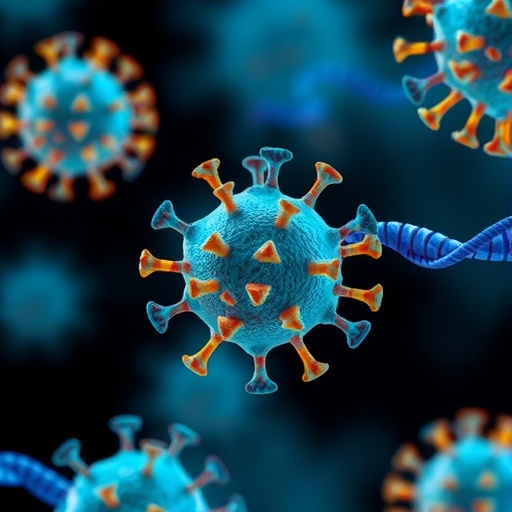In a groundbreaking study exploring the enigmatic world of microbial taxonomy and pathogenicity, researchers Chen, S., Wang, X., and Zhang, L. have delved into the genetic profiles of 97 strains of the genus Cupriavidus. Their comparative genomic investigation, recently published in BMC Genomics, sheds light on both the taxonomy of these strains and their virulence-related characteristics, marking a significant advance in understanding this lesser-known group of bacteria. This research has the potential to open new avenues for both ecological studies and biotechnological applications.
The Cupriavidus genus is largely composed of Gram-negative bacteria that are usually found in soil and water, where they play crucial roles in nutrient cycling. While some strains are known for their environmental resilience and bioremediation capabilities, others demonstrate pathogenic traits that can pose a threat to plants and animals, including humans. This dual nature of Cupriavidus strains offers a unique opportunity to investigate how genetic variation affects both ecological function and virulence.
The research team employed a robust comparative genomic analysis to dissect variations among the 97 Cupriavidus strains, utilizing high-throughput sequencing technology. Through this advanced methodological approach, they were able to assemble a comprehensive genome dataset, which allowed them to identify core and accessory genes across the different strains. Such genomic information is critical, as it lays the foundation for understanding the molecular mechanisms that enable certain strains to thrive in specific environments or cause infection.
One of the key findings of the study is the identification of virulence factors encoded within the genomes of pathogenic Cupriavidus strains. These virulence factors include genes that facilitate adherence to host tissues, evasion of the immune response, and secretion systems that can inject harmful effectors into host cells. Understanding these factors not only helps to delineate the risks posed by pathogenic strains but also contributes to the broader field of microbial pathogenesis.
Another intriguing aspect of the study is the phylogenetic analysis carried out by the researchers, which reveals the evolutionary relationships among the different strains of Cupriavidus. By constructing phylogenetic trees based on genomic data, the study provides insights into how certain strains have diverged over time and adapted to distinct ecological niches. This evolutionary perspective is essential for comprehending the biodiversity celebrated within the Cupriavidus genus and its implications for ecosystem functionality.
In addition to revealing inter-strain genetic diversity, the study discusses the potential implications for biotechnological applications. Some Cupriavidus strains are already utilized in bioremediation efforts due to their ability to degrade pollutants. The research highlights that a deeper understanding of their genetic profiles could enhance their utility in environmental cleanup operations and biotechnological innovations. Uncovering the genetic basis of traits associated with bioremediation could lead to the development of optimized strains for specific environmental contaminants.
The results of this investigation are particularly timely, given the increasing concerns over microbial resistance and pathogenicity in our changing world. The ability of certain Cupriavidus strains to adapt and even thrive in various challenging environments underscores the importance of ongoing genetic studies. The findings contribute to a growing body of knowledge regarding microbial ecology and pathogenesis, which is vital for public health, agriculture, and environmental management.
Through their meticulous analysis, Chen and colleagues have set a precedent for future studies on Cupriavidus and related genera. The utilization of comparative genomics as a framework for taxonomic and pathogenic assessment could inspire similar investigations across other taxa. Such an approach not only amplifies our understanding of the fundamental biology of microorganisms but also underscores their ecological significance.
As microbiological research continues to evolve, the insights gained from this study reflect the promising intersection of genomics, ecology, and public health. The findings serve as a reminder of the complex ecological dynamics that govern microbial communities, as well as the potential risks and benefits they may pose. The team’s revelations concerning virulence factor distribution could play an essential role in the cessation of outbreaks linked to pathogenic Cupriavidus strains, impacting clinical practices and public health measures.
In conclusion, the comparative genomic analysis of Cupriavidus strains presented by Chen, Wang, and Zhang unravels intricate interactions within microbial communities, highlighting the duality of function inherent within this genus. As researchers continue to explore microbial genetics, the implications of this study extend beyond taxonomy and into critical discussions surrounding pathogenesis and ecological preservation.
With their innovative approach, the authors have illuminated pathways for further exploration into the genomic landscapes of other environmental bacteria, promising to keep the scientific community engaged as they work toward understanding the complex web of life on Earth. The future of microbial taxonomy and virulence research is bright, enriched by findings such as those reported, demonstrating the intricate balance of nature’s design.
Subject of Research: Taxonomy and virulence-related genetic profiles in Cupriavidus strains.
Article Title: Insights into the taxonomy and virulence-related genetic profiles in 97 Cupriavidus strains through comparative genomic analysis.
Article References:
Chen, S., Wang, X. & Zhang, L. Insights into the taxonomy and virulence-related genetic profiles in 97 Cupriavidus strains through comparative genomic analysis. BMC Genomics 26, 868 (2025). https://doi.org/10.1186/s12864-025-11841-1
Image Credits: AI Generated
DOI: 10.1186/s12864-025-11841-1
Keywords: Cupriavidus, comparative genomics, virulence, taxonomy, microbial pathogenesis, bioremediation.
Tags: bioremediation capabilities of bacteriacomparative genomic analysisCupriavidus genetic diversityCupriavidus strains and human health.ecological function of bacteriaenvironmental resilience of Cupriavidusgenetic variation in pathogenic strainsGram-negative bacteria taxonomyhigh-throughput sequencing technologymicrobial taxonomy researchpathogenicity in bacteriavirulence-related characteristics





